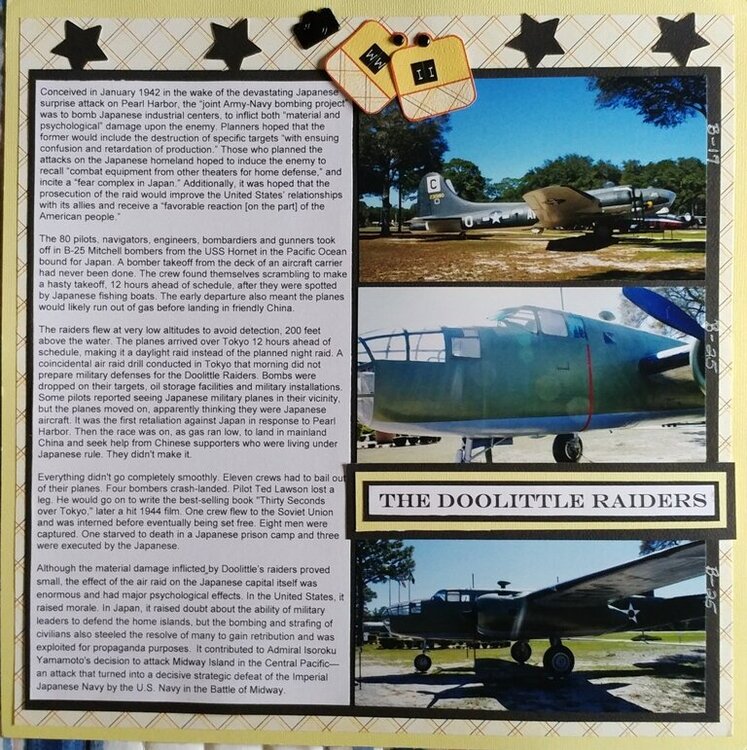EXTRA 11% OFF Orders $100+ With Code: THANKYOU


 Give a Cheer
Give a Cheer
Another page from Eglin AFB museum - think this is the last. Note the top plane is the B-17 and the other 2 are the B-25. I needed 3 photos because of the long journaling. The B-25 is the one that the Doodlittle Raiders used.
Old stash - HOTP pps (grid and solid black), tags and brad. Tim Holtz - stickers
Journaling: Conceived in January 1942 in the wake of the devastating Japanese surprise attack on Pearl Harbor, the “joint Army-Navy bombing project” was to bomb Japanese industrial centers, to inflict both “material and psychological” damage upon the enemy. Planners hoped that the former would include the destruction of specific targets “with ensuing confusion and retardation of production.” Those who planned the attacks on the Japanese homeland hoped to induce the enemy to recall “combat equipment from other theaters for home defense,” and incite a “fear complex in Japan.” Additionally, it was hoped that the prosecution of the raid would improve the United States’ relationships with its allies and receive a “favorable reaction [on the part] of the American people.”
The 80 pilots, navigators, engineers, bombardiers and gunners took off in B-25 Mitchell bombers from the USS Hornet in the Pacific Ocean bound for Japan. A bomber takeoff from the deck of an aircraft carrier had never been done. The crew found themselves scrambling to make a hasty takeoff, 12 hours ahead of schedule, after they were spotted by Japanese fishing boats. The early departure also meant the planes would likely run out of gas before landing in friendly China.
The raiders flew at very low altitudes to avoid detection, 200 feet above the water. The planes arrived over Tokyo 12 hours ahead of schedule, making it a daylight raid instead of the planned night raid. A coincidental air raid drill conducted in Tokyo that morning did not prepare military defenses for the Doolittle Raiders. Bombs were dropped on their targets, oil storage facilities and military installations. Some pilots reported seeing Japanese military planes in their vicinity, but the planes moved on, apparently thinking they were Japanese aircraft. It was the first retaliation against Japan in response to Pearl Harbor. Then the race was on, as gas ran low, to land in mainland China and seek help from Chinese supporters who were living under Japanese rule. They didn't make it.
Everything didn't go completely smoothly. Eleven crews had to bail out of their planes. Four bombers crash-landed. Pilot Ted Lawson lost a leg. He would go on to write the best-selling book "Thirty Seconds over Tokyo," later a hit 1944 film. One crew flew to the Soviet Union and was interned before eventually being set free. Eight men were captured. One starved to death in a Japanese prison camp and three were executed by the Japanese.
Although the material damage inflicted by Doolittle’s raiders proved small, the effect of the air raid on the Japanese capital itself was enormous and had major psychological effects. In the United States, it raised morale. In Japan, it raised doubt about the ability of military leaders to defend the home islands, but the bombing and strafing of civilians also steeled the resolve of many to gain retribution and was exploited for propaganda purposes. It contributed to Admiral Isoroku Yamamoto's decision to attack Midway Island in the Central Pacific—an attack that turned into a decisive strategic defeat of the Imperial Japanese Navy by the U.S. Navy in the Battle of Midway.
No products have been added to this project.
Thanks for spreading positivity!
October 22, 2018
October 22, 2018
October 22, 2018
October 22, 2018
October 21, 2018